#souls for sale 1923
Explore tagged Tumblr posts
Text






Richard Dix versus Frank Mayo (Souls for Sale)
"엘리노어 보드맨이 연기한 '리멤버'는 자기 co-star에게도, 감독에게도, 둘 다에게 사랑받는데 그게 너무 부러웠다. 이 두 남자가 서로를 질투하는 모습이 너무 재밌었고, 이러한 스토리는 딱 내 타입이었다."
-23/08/23 (사운드트랙 없는 해적판으로 이 영화 처음 본 날)
"사운드트랙은 자체가 아름답다기보다는 영화 시작할 때 오프닝타이틀 나오는 부분과 영화 끝날 때 딕스가 엘리노어 보드맨에게 키스하는 씬 보면 꼭 동화 같은 음악이 나오기 때문에 그렇게 따지면 영화 자체가 신데렐라 스토리 같은 느낌이었다. 여주인공이 여배우가 되어 명성과 지위가 있는 감독과 결혼한다는 내용. (중략) 난 프랭크 메이요와 리처드 딕스를 동등하게 생각했기 때문에 보드맨이 메이요가 아닌 딕스를 선택했기 때문에, 영화 끝장면에서 딕스가 보드맨을 코트로 덮어주고 키스할 때 나오는 동화 같은 음악에도 불구하고 결말이 무척!! 슬펐다."
-24/11/29 (워너아카이브 정식발매 DVD로 처음 본 날)




Frank Mayo in Wild Oranges (1924)
"Wild Oranges (1924)는 Souls for Sale에선 딕스 때문에 상대적으로 위축되어 (내가 보기엔) 전혀 매력을 못 ��꼈던 프랭크 메이요 주연 영화."
-24/05/30
"프랭크 메이요는 (중략) 특유의 분위기로 나를 압도한다."
-24/10/01
"그 영화가 나에게 끼친 영향력은 엄청났다. 그 영화는 날 순식간에 미국 남부의 늪지대로 데려가 살인마에 대한 두려움 속에서 살고 싶게 만들었으며, 보스턴 출신의 낯선 남자에게 구원받는 상상을 현실로 만들었으며, 순식간에 내 마음속에서 리처드 딕스와 프랭크 메이요의 위치를 뒤바꿔놓았다."
-24/12/11
*photo
Moving Picture World, January 12, 1924, p.82
.∗̥✩⁺˚♡
2 notes
·
View notes
Text





Souls for Sale (1923)

Pictures and Picturegoer, July 1924, p.22
0 notes
Text



Souls For Sale (1923) Dir. Rupert Hughes
#souls for sale#barbara la marr#eleanor boardman#silent film#silent era#classic film#old hollywood#silent film actress#1923#1920s
46 notes
·
View notes
Text

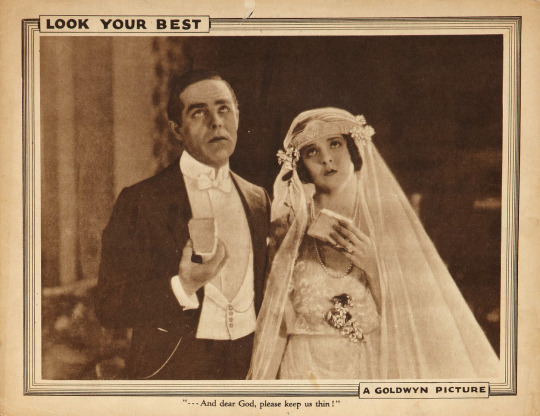

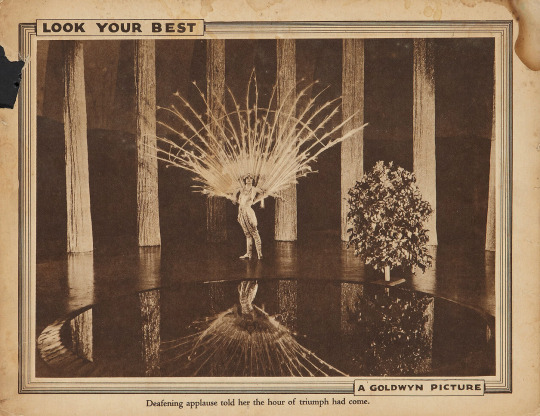
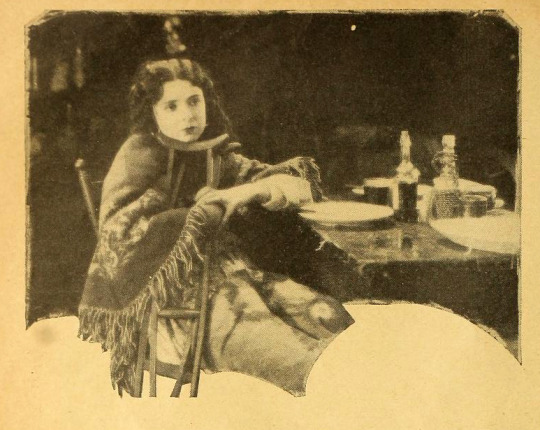


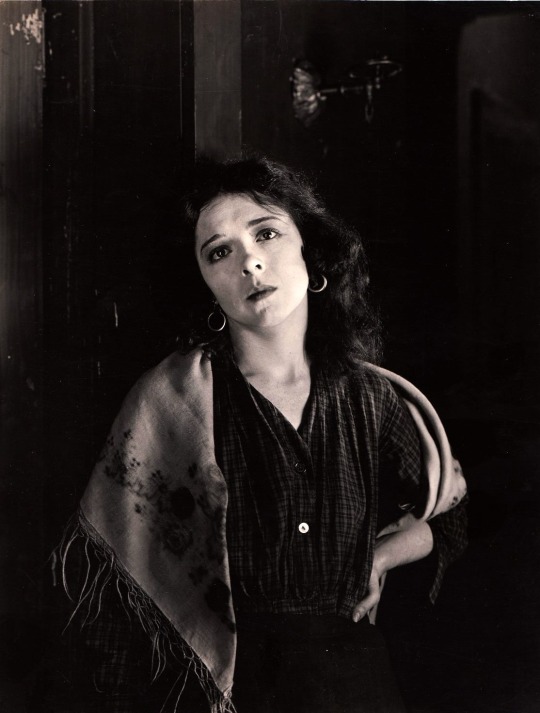

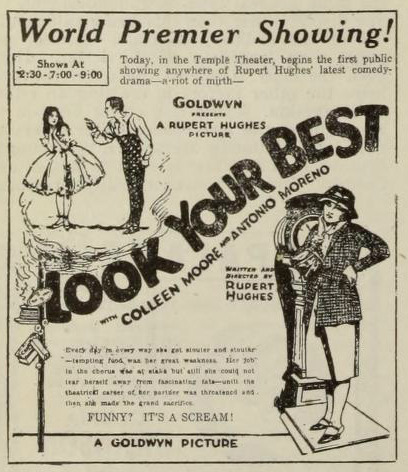
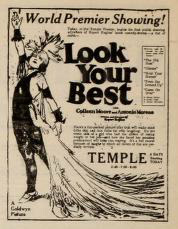
Lost, but Not Forgotten: Look Your Best (1923)
[alternate title: The Bitterness of Sweets]
Direction: Rupert Hughes
Scenario: Rupert Hughes
Camera: Norbert Brodin
Choreography: Ruth St. Denis
Studio: Goldwyn
Performers: Colleen Moore, Antonio Moreno, Earl Metcalfe, Martha Mattox, William Orlamond, Orpha Alba, Francis McDonald, Eleanor Boardman (in a bit role)
Premiere: 18 February 1923, Temple Theatre, Detroit, MI
Status: presumed entirely lost
CW: Dieting / Weight Loss
Synopsis (synthesized from magazine summaries of the plot):
On the streets of New York’s Little Italy, Perla Quaranta* (Moore) dances to the music of her father’s (Orlamond) barrel organ. Unfortunately, Perla’s mother (Alba) has a tendency to grab whatever is at hand for use as a projectile in the midst of arguments with Perla’s father. After one particularly raucous fight, her parents are arrested and sentenced to 30 days. Fortunately for Perla, the owner of a dance troupe, Carlo Bruni (Moreno) scouted her dancing on the streets and hires her to replace a recently fired dancer. The previous girl in Bruni’s “Butterfly Act” was let go after gaining too much weight to do the wirework demanded by the routine. Perla’s privation-induced petiteness is desirable for the role.
Bruni’s struggle with his weight has also apparently gotten in the way of his own work as a dancer. Perla takes well to the role and is a success in the act, which features a number of chorus girls dressed as butterflies flitting across the stage by wire. The stagehand, Krug (Metcalfe), takes a liking to Perla and takes her out regularly as the troupe goes on tour. The now gainfully-employed and avidly-courted Perla has access to all the sweets her heart desires and, in a repeat of her predecessor’s difficulties, she begins to put on pounds. Krug makes an advance on Perla, which she rebuffs. In his bitterness, Krug files Perla’s wires, assuming Bruni will blame the broken wires on her weight and fire her. During the next performance, Perla plummets to the stage and is injured.
Bruni suspects Krug of tampering with the wires, and thrashes him. Bruni is arrested and also given 30 days. While Perla recovers in the hospital, another suitor appears in the form of a baker, Cabotto (McDonald), who buoys her spirits by describing all the different delectations he serves. Meanwhile, behind bars, Bruni envisions a new ballet for the troupe with Perla in a starring role.
When Bruni is freed and Perla is recovered, they reunite and commit to dieting and to each other, via marriage. The new act depicts Perla as a white peacock killed by the hunter, played by Bruni, and mourned by an array of forest nymphs.
(At some point before the final dance number, Perla is reunited with her parents, but, from the synopses, I’m not sure of the order of events.)
* or Quaranti or Moroni based on various reviews
As a side note that I cover more in the annotations below: this plot doesn’t make much sense without a heavy dose of satire, right? The reviews didn’t leave me with a clear idea on whether the film lampoons diet culture or not and, unfortunately for us, unless somebody (maybe some sharp Michigander) makes a lucky discovery, we can’t find out for ourselves!
Transcribed sources & annotations below:
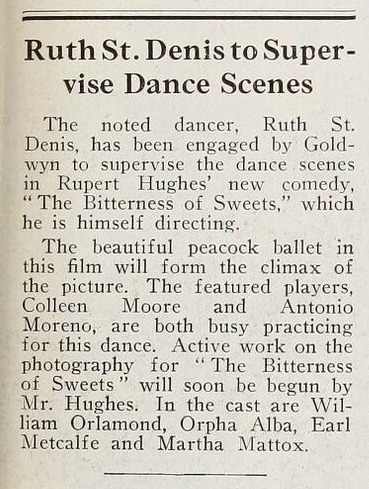
Motion Picture News, April 1922
Ruth St. Denis to Supervise Dance Scenes
The noted dancer, Ruth St. Denis, has been engaged by Goldwyn to supervise the dance scenes in Rupert Hughes’ new comedy, “The Bitterness of Sweets,” which he is himself directing.
The beautiful peacock ballet in this film will form the climax of the picture. The featured players, Colleen Moore and Antonio Moreno, are both busy practicing for this dance. Active work on the photography for “The Bitterness of Sweets” will soon be begun by Mr. Hughes. In the cast are William Orlamond, Orpha Alba, Earl Metcalfe and Martha Mattox.
—
Note: “The Bitterness of Sweets” was the working title of “Look Your Best.”
I hadn’t heard of Ruth St. Denis before now, but seeing what an important role she had in the creation of Modern Dance in America—and that she was a teacher of both Martha Graham and Louise Brooks—it’s an insult to injury that this film appears to be lost. I’m not even sure how many films St. Denis worked on! Many of the reviews below cite the dance numbers as a true highlight of the film too.
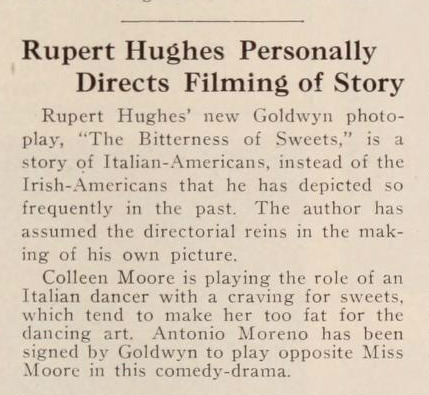
Exhibitor’s Herald, 8 April 1922
Rupert Hughes Personally Directs Filming of Story
Rupert Hughes’ new Goldwyn photoplay “The Bitterness of Sweets,” is a story of Italian-Americans, instead of the Irish-Americans that he has depicted so frequently in the past. The author has assumed the directorial reins in the making of his own picture.
Colleen Moore is playing the role of an Italian dancer with a craving for sweets, which tend to make her too fat for the dancing art. Antonio Moreno has been signed to Goldwyn to play opposite Miss Moore in this comedy-drama.

Moving Picture World, 13 May 1922
SINCE Rupert Hughes has taken to directing his own pictures at the Goldwyn studios in Culver City he has been swamped by visitors. They like to hear him spouting epigrams through his megaphone. Colleen Moore, who is now being directed by him in “The Bitterness of Sweets,“ already has jotted down the following bits:
You can’t use imitation silk before the motion picture camera. The lens is even quicker to detect imitation emotion.
Horace said: “He who would make others weep, must first have wept himself.” Every motion picture director should have that on his wall.
Ever since I was six years old people have been prophesying that I was going to kill myself with overwork. All the prophets are now dead.
We could make some very fine motion pictures if we didn’t have to bother with cameras and lights.
The censors are going to stop crime by censoring the films. Why don’t they put an end to diseases by burning the medical books which describe them?
When an actor loses control of himself he loses control of his audience.
—
Note: the timeline for the production to release of this movie is really something. They commenced filming somewhere around the end of April/early May 1922, but it wasn’t released until late February of 1923.
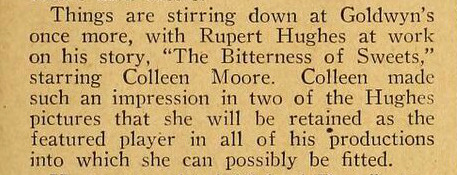
Motion Picture Magazine, June 1922
On the Camera Coast
[excerpt]
Things are stirring down at Goldwyn’s once more, with Rupert Hughes at work on his own story, “The Bitterness of Sweets,” Colleen Moore. Colleen made such an impression in two of the Hughes pictures that she will be retained as the featured player in all of his productions into which she can possibly be fitted.
—
Note: This doesn’t appear to have come to fruition?
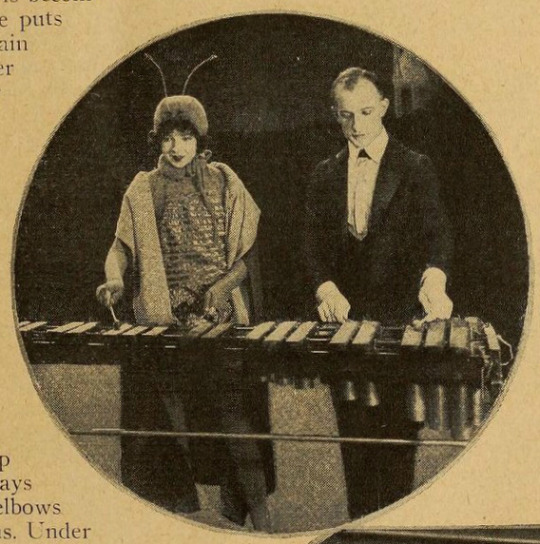
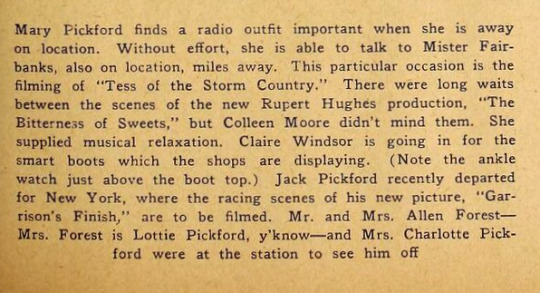
Motion Picture Magazine, September 1922
…There were long waits between the scenes of the new Rupert Hughes production “The Bitterness of Sweets,” but Colleen Moore didn’t mind them. She provided musical relaxation…

Exhibitor’s Trade Review, October 1922
Colleen Moore Sets New Record
Will Be Featured by Five Different Distributing Companies Within Space of Two Months
A record unique in the annals of the motion picture business is being set this fall by Colleen Moore, beautiful and talented young star. Exhibitors who stand by one or another distributing company and who have therefore not had the opportunity to play any of these pictures in which Miss Moore has been featured will note with interest that no less than five distributing companies will offer productions in which she is featured during the coming fall months.
First National will shortly present “Slippy McGee,” the Oliver Morosco production of Marie Conway Oemler’s well known story, in which Miss Moore plays the leading feminine role.
Goldwyn will soon release two pictures in which Miss Moore will be featured. The first will be Rupert Hughes’ production of “The Bitterness of Sweets,” which was personally directed by the author. Tony Moreno plays opposite Miss Moore in this production. The second Goldwyn feature will be “Broken Chains,” the widely advertised $10,000 prize story which was transferred to the screen under the capable direction of Allen Holubar.
Hodkinson has already delivered to its exchanges the prints of “Affinities,” a picturization of the Mary Roberts Rhinehart story of the same name. This is a Ward Lascelle production in which Miss Moore is starred.
Universal announces that Miss Moore will soon be seen in the featured feminine role in “Forsaking All Others,” a drama which has just been completed under the direction of Emile Chautard. It will be released as a Jewel special.
Rounding out the quintet, Vitagraph is now nearing completion of a picturization of the famous old stage success “The Ninety and Nine,” with Miss Moore in the featured role and directed by Dave Smith. This production will also be a special release.
—
Note: Slippy McGee (premiered June 1923, status unknown) , Broken Chains (premiered December 1922, extant), Affinities (premiered October 1922, status unknown), Forsaking All Others (premiered December 1922, status unknown), The Ninety and Nine (premiered December 1922, only 10 minutes of the film survive (available on Undercrank Productions’ Accidentally Preserved Vol. 4))
This item implies that LYB was intended for release in the fall/winter of 1922, though an exact date isn’t given.
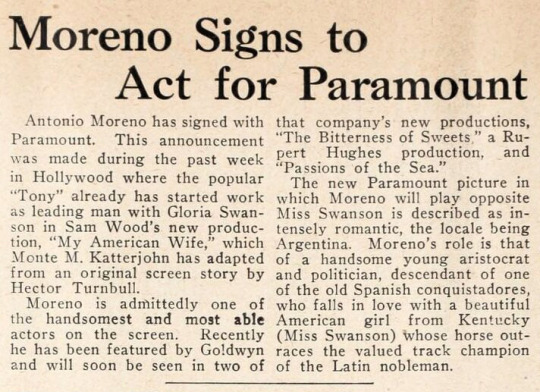
Moving Picture World, October 1922
Moreno Signs to Act for Paramount
Antonio Moreno has signed with Paramount. This announcement was made during the past week in Hollywood where the popular “Tony” already has started work as leading man with Gloria Swanson in Sam Wood’s new production, “My American Wife,” which Monte M. Katterjohn has adapted from an original screen story by Hector Turnbull.
Moreno is admittedly one of the handsomest and most able actors on the screen. Recently he has been featured by Goldwyn and will soon be seen in two of that company’s new productions, “The Bitterness of Sweets,” a Rupert Hughes production, and “Passions of the Sea.”
The new Paramount picture in which Moreno will play opposite Miss Swanson is described as intensely romantic, the locale being Argentina. Moreno’s role is that of a handsome young aristocrat and politician, descendant of one of the old Spanish conquistadores, who falls in love with a beautiful American girl from Kentucky (Miss Swanson) whose horse out-races the valued track champion of the Latin nobleman.
—
Note: My American Wife (premiered February 1923, status unknown), Passions of the Sea (premiered in February 1923 as Lost and Found on a South Sea Island, extant)

Motion Picture News, February 1923
Pre-release Reviews of Features
“Look Your Best ”
Goldwyn—Six Reels
(Reviewed by Charles Larkin)
TO EAT, to grow fat, to spoil one’s career. To starve, to keep thin, to become a great artiste. That is the choice given Perla Quaranta, a little Italian girl portrayed by Colleen Moore, who is one day noticed dancing in the streets by Carlo Bruni, manager of a small theatrical troupe, and who is given the place of the chorus lady who has fallen to the temptation of too many sweets, with the result that the perfect 36 has developed into an imperfect 40 or so. Perla is a success in the act but as she goes from town to town, accepting invitations from Krug, a stage hand, to dine, she also begins to take on weight. Krug, maddened at her coldness, when he makes advances, weakens the wire that holds Perla aloft in a butterfly stunt and she falls to the stage. Krug thought he could tell the folks Perla’s avoirdupois was to blame. Bruni, however, knocks Krug for a goal and gets thirty days for his gallantry. However, thirty days pass soon in some jails, and Bruni is soon out and starting a new ballet with Perla.
And so it goes. It isn’t much of a picture and there is a fight between Perla’s mother and father which takes up much footage and could be eliminated much to the improvement of the story. In fact, the dropping of these two characters throughout would not be missed in the least. To see a boisterous hurdy gurdy grinder jump from jail into a theatre box in a dress suit is not being done these days. There is a very artistic ballet scene toward the end of this picture.
This is not the best thing Rupert Hughes has written and adapted for the screen. Neither is it his best directed picture. Of course, one can’t expect any company to continue releasing masterpieces all the time. We can’t have a “Christian” every day. There have got to be some program pictures once in a while. This is one. It will serve its purpose and is suitable for second-class downtown houses, and there may be many who may find much humor in its fat and thin theme—especially those who are fighting either evil.
The Cast
Perla Quaranta…Colleen Moore
Carlo Bruni…Antonio Moreno
Pietro…William Orlamond
Nella…Orpha Alba
Krug…Earl Metcalfe
Mrs. Blitz…Martha Mattox
Alberto Cabotto…Francis McDonald
By Rupert Hughes. Directed by Rupert Hughes. Scenario by Rupert Hughes. Photographed by Norbert Brodin.
The Story—Deals with the horror in which some folks hold plain good old fat. A chorus girl having attained this terrible state, is fired and Perla, a daughter of Little Italy, is given her place in Bruni’s “Butterfly Act.” Perla made good and went on the road with the show. She also went out to dine with one Krug and began to put on flesh. Krug, a disappointed suitor, filed one of the wires which held Perla aloft in the butterfly stuff. During the act she crashed to the stage. Bruni beats up Krug and gets 30 days. Emerging from jail he starts a new ballet, engages Perla and the two rise to fame.
Classification—One of Rupert Hughes’ problem plays—the problem of keeping thin.
Production Highlights—Colleen Moore’s characterization of the role of the little Italian girl. The crashing of Perla to the stage floor as a result of the villain weakening the wire which holds her.
Exploitation Angles—The title. The eat and grow thin or fat as you will theme offers a chance to tie up with the health department, Y. W. C. A. women’s walking clubs, etc.
—
Note: “Deals with the horror in which some folks hold plain good old fat.” There’s only so much I can assume about the movie’s treatment of weight gain and dieting, as it is lost, but from all the synopses I read, I gotta say as a plot device it doesn’t seem to make much sense? Like, obviously in the performing arts, the expectation to stay at one precise size is stricter than in other fields, but it seems like there is no real logic at play here? I’m glad this reviewer points out that it comes off as Rupert Hughes just hating fat people. Another reviewer mentions a noteworthy lack of satire in the film, and, from the details in the synopses, it seems like this plot would only really make sense if it were a satire or critique on diet culture.
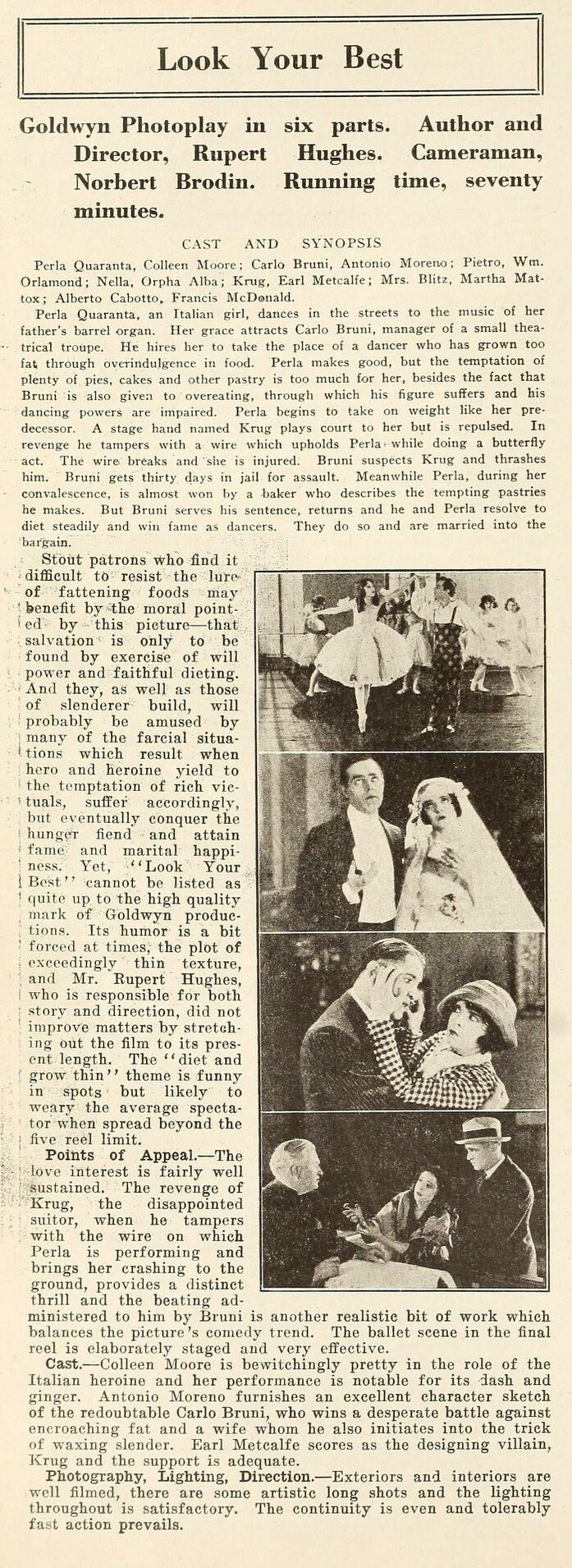
Exhibitor’s Trade Review, February 1923
Look Your Best
Goldwyn Photoplay in six parts. Author and Director, Rupert Hughes. Cameraman, Norbert Brodin. Running time, seventy minutes.
CAST AND SYNOPSIS
Perla Quaranta, Colleen Moore; Carlo Bruni, Antonio Moreno; Pietro, Wm. Orlamond; Nella, Orpha Alba; Krug, Earl Metcalfe; Mrs. Blitz, Martha Mattox; Alberto Cabotto, Francis McDonald.
Perla Quaranta, an Italian girl, dances in the streets to the music of her father’s barrel organ. Her grace attracts Carlo Bruni, manager of a small theatrical troupe. He hires her to take the place of a dancer who has grown too fat through overindulgence in food. Perla makes good, but the temptation of plenty of pies, cakes and other pastry is too much for her, besides the fact that Bruni is also given to overeating, through which his figure suffers and his dancing powers are impaired. Perla begins to take on weight like her predecessor. A stage hand named Krug plays court to her but is repulsed. In revenge he tampers with a wire which upholds Perla while doing a butterfly act. The wire breaks and she is injured. Bruni suspects Krug and thrashes him. Bruni gets thirty days in jail for assault. Meanwhile Perla, during her convalescence, is almost won by a baker who describes the tempting pastries he makes. But Bruni serves his sentence, returns and he and Perla resolve to diet steadily and win fame as dancers. They do so and are married into the bargain.
Stout patrons who find it difficult to resist the lure of fattening foods may benefit by the moral pointed by this picture—that salvation is only to be found by exercise of will power and faithful dieting. And they, as well as those of slenderer build, will probably be amused by many of the farcical situations which result when hero and heroine yield to the temptation of rich victuals, suffer accordingly, but eventually conquer the hunger fiend and attain fame and marital happiness. Yet, “Look Your Best” cannot be listed as quite up to the high quality mark of Goldwyn productions. Its humor is a bit forced at times, the plot of exceedingly thin texture, and Mr. Rupert Hughes, who is responsible for both story and direction, did not improve matters by stretching out the film to its present length. The “diet and grow thin” theme is funny in spots but likely to weary the average spectator when spread beyond the five reel limit.
Points of Appeal.—The love interest is fairly well sustained. The revenge of Krug, the disappointed suitor, when he tampers with the wire on which Perla is performing and brings her crashing to the ground, provides a distinct thrill and the beating administered to him by Bruni is another realistic bit of work which balances the picture’s comedy trend. The ballet scene in the final reel is elaborately staged and very effective.
Cast.—Colleen Moore is bewitchingly pretty in the role of the Italian heroine and her performance is notable for its dash and ginger. Antonio Moreno furnishes an excellent character sketch of the redoubtable Carlo Bruni, who wins a desperate battle against encroaching fat and a wife whom he also initiates into the trick of waxing slender. Earl Metcalfe scores as the designing villain, Krug and the support is adequate.
Photography, Lighting, Direction.—Exteriors and interiors are well filmed, there are some artistic long shots and the lighting throughout is satisfactory. The continuity is even and tolerably fast action prevails.

Motion Picture Magazine, March 1923
Comments on Numerous Productions
LOOK YOUR BEST — GOLDWYN
Rupert Hughes gets off on a different tack in this, his latest expression. He makes a plea to be on the look-out for adipose tissue as a destroyer of beauty. And he argues his point thru a weirdly melodramatic story of a chorus girl who develops obesity and is discharged as a result. A slender girl is taken on and proves a sensation. Comes then a bit of Italian jealousy when a disappointed lover files the wires in the ballet number, causing the little “butterfly” to crash to the stage. Mr. Hughes’s satiric vein is missing here. In fact you wouldn’t recognize his style here at all. It’s breath-taking, now and then, but many of the scenes are clumsily executed and the characters are not deftly drawn. Colleen Moore succeeds in being genuine, as usual, in her portrayal of the ballet girl. And Tony Moreno is a satisfactory lover—of the hot Italian school.
---
Note: Interesting point here that there is a lack of “Hughes’ satiric vein.” I haven’t seen much of his work as of yet, so I don’t know what sort of satire would be typical of Hughes’ work. However the plot details laid out across various reviews and synopses don’t just strain credibility they tear it to shreds, UNLESS the whole thing was a satire on diet culture, but as far as I can tell, it’s just straight-up fatphobia. A shame, for sure, because this sort of story told as a lampooning of diet culture honestly sounds pretty darn entertaining.

Motion Picture Magazine, March 1923
Rupert Hughes went out to the Palm Springs on the edge of the desert to make the opening scenes of the film version of his novel “Souls for Sale.” It suddenly began to rain in the way rain comes down in the desert and the company was stuck there in idleness for a week. Claire Windsor, Richard Dix, Frank Mayo, Lew Cody and other well known actors will be in the cast. It has always been supposed that Maj. Hughes drew the heroine of his story to a certain extent from Claire Windsor, altho, of course, with liberal modifications. It almost went without saying that she would have the part when the story was screened.
The name of Maj, Hughes’ story, “The Bitterness of Sweets,” has been changed to “Look Your Best.” This was the picture in which Colleen Moore appeared as a dancer.
—
Note: Considering the extended timeline between the production and release of Look Your Best, the production of Souls for Sale (premiered March 1923, extant) commenced directly after LYB wrapped. So, Hughes’ second and third feature for Goldwyn premiered within a month of each other, with Souls for Sale being a larger production and more heavily marketed. I’m wondering if holding off on the release of Look Your Best was due to a lack of faith in the final product and a desire not to prematurely tarnish the rep of a writer/director that Goldwyn had just signed on for a lot of pictures? That is, releasing it close to Souls for Sale seems like a smart call because Souls for Sale’s quality and higher box-office potential would likely minimize any doubts about Hughes’ abilities that might arise if his second film for Goldwyn was as underwhelming as reviewers and exhibitors portray it. Alternatively or additionally, maybe the studio deemed LYB a “programmer” after production wrapped and was simply waiting for a better time on their release schedule.
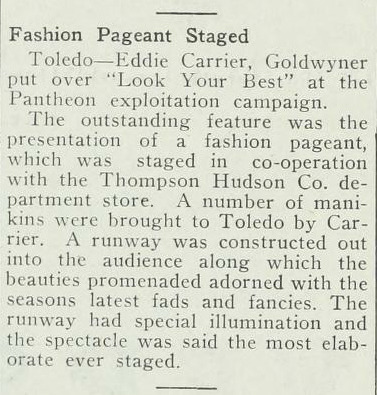
The Film Daily, 30 March 1923
Putting It Over
Here is how a brother exhibitor put his show over. Send along your ideas. Let the other fellow know how you cleaned up.
Fashion Pageant Staged
Toledo—Eddie Carrier, Goldwynner put over “Look Your Best” at the Pantheon exploitation campaign.
The outstanding feature was the presentation of a fashion pageant, which was staged in co-operation with the Thompson Hudson Co. department store. A number of manikins were brought to Toledo by Carrier. A runway was constructed out into the audience along which the beauties promenaded adorned with the seasons latest fads and fancies. The runway had special illumination and the spectacle was said the most elaborate ever staged.
—
Note: There are a number of news items about exploitation schemes for the film that tie in with other local businesses, but, humorously, the tie-ins are with department stores and have to do with fashion and cosmetics, when that seemingly has nothing to do with a movie about vaudeville performers and dieting!
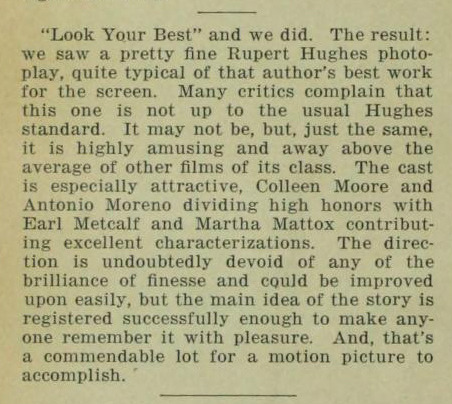
Camera, 30 March 1923
THE SILENT TREND
Composite of Views, Previews, and Reviews of Motion Pictures.
“Look Your Best” and we did. The result: we saw a pretty fine Rupert Hughes photoplay, quite typical of that author’s best work for the screen. Many critics complain that this one is not up to the usual Hughes standard. It may not be, but, just the same, it is highly amusing and away above the average of other films of its class. The cast is especially attractive, Colleen Moore and Antonio Moreno dividing high honors with Earl Metcalf and Martha Mattox contributing excellent characterizations. The direction is undoubtedly devoid of any of the brilliance of finesse and could be improved upon easily, but the main idea of the story is registered successfully enough to make anyone remember it with pleasure. And, that’s a commendable lot for a motion picture to accomplish.

Motion Picture News, April 1923
Elaborate Style Show Put Over with “Look Your Best”
Toledo, Ohio.—The management of the Pantheon theatre, in conjunction with Goldwynner Eddie Carrier, put on an elaborate exploitation campaign on “Look Your Best,” the outstanding feature of which was a fashion pageant staged in co-operation with the Thompson-Hudson Company, a leading department store.
A bevy of beautiful mannequins was assembled, and a runway was built far out into the audience, on which they promenaded with the latest fashion creations. Special lighting and scenic effects were used and a musical score was provided for the occasion. The department store co-operated with a double-page ad, seven full window displays and 2,500 letters to its customers.
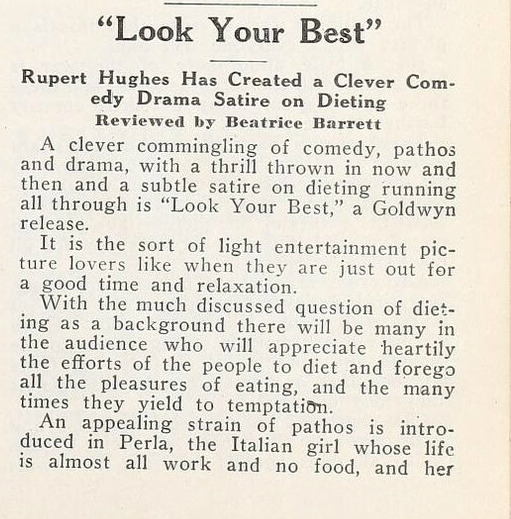

Moving Picture World, April 1923
“Look Your Best”
Rupert Hughes Has Created a Clever Comedy Drama Satire on Dieting
Reviewed by Beatrice Barrett
A clever commingling of comedy, pathos and drama, with a thrill thrown in now and then and a subtle satire on dieting running all through is “Look Your Best,” a Goldwyn release.
It is the sort of light entertainment picture lovers like when they are just out for a good time and relaxation.
With the much discussed question of dieting as a background there will be many in the audience who will appreciate heartily the efforts of the people to diet and forego all the pleasures of eating, and the many times they yield to temptation.
An appealing strain of pathos is introduced in Perla, the Italian girl whose life is almost all work and no food, and her childish pleasure in her first nice clothes. Colleen Moore does well this wistful role. There is always a fascination about life back of the curtain and there are many scenes here of the rehearsals and scenes in the dressing rooms that will attract.
Very beautiful are the scenes of the Butterfly Girls with great gauze wings executing their dance and then suspended on wires flying through the air. The stage sets and the dance which Antonio Moreno and Colleen Moore do at the end of the picture is also very artistic and gives an air of a big production to what at times seems to be simply a comedy.
Rupert Hughes worked up through many laughs to the big thrill of the cut wire and has handled very well these scenes with the girl flying through the air coming right toward the camera—and all the while the audience knows the wire is going to break—and it does and there is a fall that will give them a shudder.
The plot is a gossamer one, and simply a thread which lightly holds together the events of the story—but in a picture of this character you don’t expect much plot. The audience will be chuckling and enjoying each new incident as it comes along.
Cast
Perla Moroni…Colleen Moore
Carlo Bruni…Antonio Moreno
Pietri…William Orlamond
Nella…Orpha Alba
Krug…Earl Metcalf
Mrs. Blitz…Martha Maddox
Alberta Cobatto…Francis MacDonald
Written and directed by Rupert Hughes.
6 reels.
Story
Perla, a half starved Italian girl, is engaged by Bruni to be one of his butterfly dancers because she is so thin. Krug, the wireman, becomes infatuated with Perla. She begins to get fat, and when she tires of Krug’s attentions he files the wire on which she hangs as a butterfly so Bruni will think she is too fat for the part and discharge her. Bruni used to be a beautiful dancer but through love of food grew too fat and could no longer dance. He and Perla both start to diet. He composes a beautiful dance for them and they are a great success. The story ends with their wedding—and the two still dieting.
—
Note: Now, this reviewer thinks the film is a satire of dieting?

Exhibitor’s Herald, 7 April 1923
COLLEEN MOORE IN
LOOK YOUR BEST
(GOLDWYN)
A cheerful little story of an Italian girl who becomes an actress and then has a hard time keeping her job because of overeating. An interesting picture of backstage life, and although not one of Rupert Hughes greatest plays, is quite satisfying. Author: Rupert Hughes; Continuity: Rupert Hughes; Director: Rupert Hughes. Length six reels.
There is just a little over an hour’s pleasant diversion in this latest Rupert Hughes-Goldwyn production. It is a quaint mixture of pathos, humor and drama. The humor borders on the slapstick, while the melodrama is the good old-fashioned “s-death” kind. However, there is the ever appealing Colleen Moore in it, as the interesting little toe dancer, and Antonio Moreno as a ballet master. Add to these William Orlamond, as Pietro; Orpha Alba, as Bella, his wife; Earl Matcalfe, as Krug, the villain; Martha Mattox, ad Mrs. Blitz; and Francis McDonald, as Cabotto, a suitor for Perla’s hand, and you have a cast capable of good things.
At the State-Lake theater, Chicago, where the picture followed the trained seals, it got a few laughs and held the attention of a vaudeville-loving audience. And you’ll certainly enjoy Colleen Moore more and more.
The story concerns Perla, a little New York girl of Italian parentage who goes into Bruni’s butterfly dance act in vaudeville and finds she must deny herself the sweets she loves in order to remain slender. The man who manipulates the wires, failing to win her love, plots to get her discharged for putting on too much flesh. He cuts the wire supporting her, but Bruni discovers his treachery and engages him in a fight, which lands both in jail, but on Bruni’s release Perla is waiting to reward him with her hand.

Screen Opinions, June 1923
“LOOK YOUR BEST”— [Class B] 65%
(Especially prepared for screen)
Story:—Romance of Little Italy, a Girl and a Theatrical Manager
VALUE
Photography—Very good—Norbert Brodin.
TYPE OF PICTURE—Entertaining.
Moral Standard—Average.
Story—Good—Comedy-drama—Family.
Stars—Good—Colleen Moore and Antonio Moreno.
Author—Good—Rupert Hughes.
Direction—Good—Rupert Hughes.
Adaptation—Good—Rupert Hughes.
Technique—Good.
Spiritual Influence—Neutral.
CAST
Perla Quaranti…Colleen Moore
Carlo Bruni…Antonio Moreno
Pietro…William Orlamond
Nella…Orpha Alba
Krug…Earl Metcalfe
Mrs. Blitz…Martha Mattox
Alberto Cabotto…Francis McDonald
June 1 to 15, 1923.
Producer—Goldwyn
Footage—6,000 ft.
Distributor—Goldwyn
Our Opinion
MORAL O’THE PICTURE—If You Would Look Well, Mind Your Diet.
Not Particularly Artistic, but Makes Good Entertainment—Stars Do Well
Scenes in Little Italy, in which an Italian organ grinder and his wife are forced to serve a thirty-day sentence in jail following a knife and china shower, are fraught with comedy, and so also is the initiation of Perla, the pretty daughter, into the stage technique of playing butterfly and being hoisted on a wire to flutter her butterfly wings. Colleen Moore is charming in the role of Perla, and one of the notably good performances of the picture is done by Orpha Alba, who plays the role of Nella Quaranti, Perla’s mother, who, between laughter and tears, chastises her husband, Pietro, with the first article that comes to hand, no matter what the substance is, and then makes parting at the jail “such sweet sorrow.” William Orlamond is the type for Pietro, and Antonio Moreno, as Bruni, whose theatrical grace was spoiled by too much eating, is also very good. Earl Metcalfe, as Krug, elected to serve as Perla’s wire hoister, in love with her and reproachful when he failed to obtain kisses in return for the food that made Perla “not as thin as she used to was,” is all that the role requires—he does well. Francis McDonald is the baker joy and jealous lover, and looks and acts the part. The picture contains some attractive stage scenes with the butterfly girls flitting rapidly past the camera, and there is also an elaborately staged classic dance, supposed to take place in the greenwood, in which Colleen Moore is dressed as a white peacock, which is slain by the hunter, Antonio Moreno, and mourned by the wood nymphs. This is really a very enjoyable feature.
STORY OF THE PLAY
Perla Quaranti, a street dancer, finds herself alone when her father and mother are sentenced to thirty days in jail for fighting. She is offered a position by Carlo Bruni, an Italian theatrical manager, whose specialty is a group of butterfly girls. Perla, filling the place of a girl who got too stout to hoist, grasps good fortune by the neck and eats herself stout also on the bounty of one Krug, a wirehoister. Krug plays her false when he realizes that she loves Bruni instead of himself, and takes revenge by cutting the wire so that during the whirl of butterflies Perla falls to the stage and is injured. The story closes happily with Perla and her parents reunited, and Bruni her prospective husband.
PROGRAM COPY—”Look Your Best”—Colleen Moore and Antonio Moreno
Perla Quaranti’s butterfly days ended with a bang when a jealous lover took revenge for lack of kisses. Don’t miss seeing Colleen Moore, Antonio Moreno and an excellent cast in “Look Your Best,” one of the funniest and most original of recent comedies.
—
Note: This is the only review that adds detail about Perla’s parents. Another reviewer complained that the bits with her parents were wholly superfluous. Other reviewers barely mention that they are even in the film!
Moving Picture World, 9 June 1923
Sells First Showing on the Type Argument
The Temple Theatre, Detroit, does not believe in too much splash, even for a world premier, and gets along very nicely with 100 by 3 for Look Your Best, using two cuts and six lines of snappy stuff about the nature of the play to back up the illustrations. Apparently these illustrations are from the plan book, and they have no strong illustrative value, but the upper one suggests the stage story, which this is, and the lower the growing weight of Colleen Moore, which is the essence of the plot. The selling value lies chiefly in the talk, and here this talk is a quiet little chat about the play with no particular stress, just an intimate tip-off on the nature of the play which is more convincing than a many-adjectived oration could possibly be. It is so good that it might have been put into larger type, even at the cost of one of the cuts. And make a note now that Look Your Best is going to make a wonderful peg for hook-up pages and style shows. Combine the two of them by starting early enough to get your plans all properly laid. There are a lot of similar co-operative angles, but these will be the best bets. -P. T. A.-
Poster blurb: Every day in every way she gets stouter and stouter—tempting food was her great weakness. Her job in the chorus was at stake but still she could not tear herself away fascinating fats—until the theatrical career of her partner was threatened and then, she made the grand sacrifice.
FUNNY? IT’S A SCREAM!
— Note: photo of the interior of the now demolished Temple Theatre, a popular vaudeville venue.
---
Exhibitor’s Trade Review, July 1923
SLOGAN BASIS OF MERCHANT TIE-UP
Madison, Wis.—A merchant tie-up on a “Look Your Best” Week was put across by Dr. Wm. E. Beecroft, manager of the Parkway Theatre, and Goldwynner W.D. Nealand, in connection with the screening of “Look Your Best.” Art Kniseley, advertising manager of the Burdick & Murray Department Store, went in heavily with the theatre management on this “Look Your Best” week.
He gave the picture a splendid window display, using the slogan “Look Your Best” as a sales aid for their clothing, millinery, hosiery and toilet articles. In addition to the window display, Mr. Kniseley ran a sixty-eight inch advertisement in both the State Journal and the Capitol Times, tieing up with “Look Your Best.”
---
Moving Picture World, September 1923
Consensus of Published Reviews
Look Your Best
(Colleen Moore—Goldwyn—6 reels)
M. P. W.—A clever commingling of comedy, pathos and drama, with a thrill thrown in now and then and a subtle satire on dieting.
E. H.—Is a cheerful little story of backstage life. It was written and directed by Rupert Hughes, and although not his greatest play, will be found highly diverting as an hour’s entertainment.
N.—It will serve its purpose and is suitable for second-class downtown houses.
T. R.—The “diet and grow thin” theme is funny in spots but likely to weary the average spectator.
---
Picture Play Magazine, October 1923
Keeping Nature’s Gifts
[excerpt]
Colleen Moore’s diet depends upon whether she is putting on flesh for a picture or taking it off. She lived practically on lemon-juice for two weeks, losing ten pounds at the start of “Look Your Best.” For the last scenes she had to regain her avoirdupois, so she went to bed for a week, drank milk-two or three quarts a day and ate cakes and everything.
—
Note: I hate this.
---
Exhibitor’s Herald, 24 November 1923
Goldwyn Cosmopolitan
Look Your Best, with Colleen Moore. —A very good picture that failed to score at all at the box office. I have played ten of these pictures, losing money on eight, breaking even on one, so I really will be glad when they are over with. The advertising matter is my greatest drawback, for I’m a little fellow and can’t afford an artist to make my lobby and have to use their stock stuff, which is bum considering the attractions they represent. Pretty enough, but do not run true with the films. Seven reels.—Hugh G. Martin, American theatre, Columbus, Ga.—General patronage.
Look Your Best, with Colleen Moore and Antonio Moreno.—Two dandy stars wasted in this. Rupert Hughes was unable to convince an audience of movie fans what he was driving at. Lacked interest all the way. Not worth bothering about.—Ben L. Morris, Temple theatre, Bellaire, Ohio.—General patronage.
---
Moving Picture World, December 1923
LOOK YOUR BEST. (6 reels). Star, Colleen Moore. A very ordinary picture that I played on a Saturday night and put in a strong line of fillers and in that way escaped censure. You can play this, but be careful of your accompanying selections and buy it right. Usual advertising brought good attendance. Draw health seekers and tourists. Dave Seymour, Pontiac Theatre Beautiful, Saranac Lake, New York.
LOOK YOUR BEST. (6 reels). Star cast. Nice little comedy-drama. Very light in construction. Seemed to please. Had fair attendance. Draw all classes in town of 1,000. Admission 15-25. Jack Kaplan, Rivoli Theatre (378 seats), South Fallsburg, New York.
---
Best Moving Pictures, 1922-1923
LOOK YOUR BEST. Produced and distributed by Goldwyn. Six reels. Released February 18, 1923. Cast: Colleen Moore and Antonio Moreno. Director, Rupert Hughes. Story of a chorus girl who tried to keep thin.
---
The Educational Screen, February 1924
THE THEATRICAL FIELD
LOOK YOUR BEST (Goldwyn)
Colleen Moore and Antonio Moreno demonstrate the tragic fact that life is very bitter to the lover of sweets when his job depends on his remaining thin. Fair entertainment, making no demands on either actors or audience.
---
Motion Picture Magazine, November 1924
Every Little Bit Helps—to Stardom
By HARRY CARR
[excerpt]
Eleanor Boardman came to the old Goldwyn lot and jumped at once into the top line by a tiny scene in Rupert Hughes’ The Bitterness of Sweets, in which she fainted in a theater box.
—
Note: Given what I noted earlier about the release dates of LYB and Souls for Sale, finding out that a bit role in LYB (here referred to by its working title) led to Eleanor Boardman’s starring role in the latter film is fascinating. Boardman likely filmed her single scene in LYB months before production started on Souls for Sale, which she is the star of. But, because the release of LYB was delayed, Boardman had a bit role and a starring role on screens within a month of each other!
#Look Your Best#The Bitterness of Sweets#lost film#silent comedy#silent era#silent film#silent movies#1920s#1922#1923#Rupert Hughes#Colleen Moore#antonio moreno#eleanor boardman#classic movies#classic film#american film#movie magazine#film magazine#Souls for Sale#ruth st. denis#film history#lost but not forgotten
15 notes
·
View notes
Text

1923 Poster or ad for "Souls for Sale" from Silent Era and Pre Code Art, FB.
78 notes
·
View notes
Photo


The Haunted Mortuary New Orleans
In New Orleans, graveyards makes a perfect back drop for a haunted attraction. However, The Haunted Mortuary is a bit more special than most. This attraction is set up in an actual haunted mansion. The massive three-story building was constructed in 1872 by Mary Slattery.
Her intentions was to build a home for generations of her family. Mary and her husband John had six children. Family friends Mr. and Mrs. John Kane also lived with the Slatterys. In October 1905, the house was sold to Mrs. Marie Lafontear and William Klein who maintained it until May 15, 1923. Then, it was purchased on behalf of PJ McMahon in 1928 as the future site of a grand funeral home called PJ McMahon and Sons. In 1959, an ambitious building project was launched adding a specially designed elevator, a rear garage for the discrete delivery of the dead, additional viewing rooms and offices. At its height, the building featured amenities found in only the nicest of mansions such as smoking parlors for the men, private bedrooms and apartments with separate baths for the bereaved, maid service, an on-site cook, dining facilities, chaise lounges for the ladies in their private bathrooms and private drawing rooms. The purpose was to mimic the comforts of home and rivaled all but a few of the grandest of residences of New Orleans.
PJ McMahon and Sons was a full-service funeral home. There was an autopsy room and an embalming room as well as a crematorium onsite, cold storage for the dead, casket storage, casket sales and a flower sales facility. The property was designed to anticipate and take care of every aspect of the funeral business. PJ McMahon and Sons was massively successful, performing an estimated twenty thousand funerals. On April 29th 1985, PJ McMahon and Sons merged with the Security Industrial Funeral Home Corporation. The building transferred owners a few times over the years. On March 23, 2004, EHN2 Holdings, also known as Neil Corporation which owns Aveda’s Spas purchased the mansion.
Neil Corp’s goal was to turn the ornate funeral home into a Day Spa Academy. They gutted the property due to its poor condition and the hazardous materials throughout the building. Almost everything was removed. All that was left was the wood framing, doors and the staircases of the building. In this process, the CEO of Neil Corp died by somewhat mysterious circumstances and their board decided to discontinue the project. The gutted building was listed for sale in 2004, remaining empty and abandoned for three years. During this period, Hurricane Katrina swept through in 2005. The mansion survived the storm due to being located on high ground. In July 2007, Jeff Borne, the owner of PSX Audio/Video Technologies purchased it, turning the house in to the Mortuary Haunted House that it is today.
The many souls who passed through PJ McMahon and Sons Funeral Home may never have left. A woman in white has been seen on the top floor crying for her long dead husband. A tall well-dressed man is said to appear whenever someone is disrespecting the cemeteries that surround the property. Two rambunctious ghost children, a boy and girl, have been known to play pranks on visitors. A former mortician is often seen in the basement continuing his bloody work beyond the grave. Other activity includes, footsteps, whispers, furniture moving on its own, and poltergeist activity.
#The Haunted Mortuary#haunted#haunted locations#ghost and hauntings#ghost and spirits#paranormal#haunted salem#myhauntedsalem
11 notes
·
View notes
Text

Mae Busch "Almas en venta" (Souls for sale) 1923, de Rupert Hughes.
8 notes
·
View notes
Text
Mary Mallory / Hollywood Heights: Columbia Picture’s Centennial and Early Film ‘Mary of the Movies’
Hollywood grew from a small rural community into a city of massive movie studios in the early 1920s, as tens of thousands arrived hoping to become part of the entertainment bonanza. Cashing in on the city and industry’s popularity, studios released several films in 1923 focusing on young women attempting to break into the movies. Two survive, “Souls For Sale” and “The Extra Girl,” with…

View On WordPress
0 notes
Text
Souls for Sale (1923)
2 notes
·
View notes
Text




"The purest love includes complete belief in the loved one. When jealousy enters, that love cannot be the purest."
-Frank Mayo, "Is Woman's Love Greater Than Man's?" Motion Picture Magazine, August 1923, p.99
* ੈ✩‧₊˚* ੈ✩‧₊
* ੈ✩‧₊˚* ੈ✩‧₊
0 notes
Text







Barbara La Marr in Souls for Sale (1923) Dir. Rupert Hughes
#barbara la marr#souls for sale#silent film#silent era#old hollywood#classic film#silent film actress#1923#1920s
41 notes
·
View notes
Text
100th Anniversary Movie Festival: Souls for Sale (1923)
Title: Souls for Sale Release Date: March 27, 1923 Director: Rupert Hughes Production Company: Goldwyn Pictures Summary/Review: Remember “Mem” Steddon (Eleanor Boardman) makes the quick decision to marry Owen Scudder (Lew Cody), but as their train passes through the desert on the way to Los Angeles, she gets a bad feeling about him and abandons the train. Good thing too, because Scudder is a…

View On WordPress
0 notes
Photo
This a cameo Charlie Chaplin did for 1923 film “Souls for Sale”, he playing the part of himself as director.
This film is peppered with several cameos of the stars of the day. Here a link to film the Chaplin at minute mark 28 (x)

Charlie Chaplin
42 notes
·
View notes
Text

1923 Members of the cast of the silent film "Souls For Sale". From Barbara LaMarr: The Girl Who Was Too Beautiful for Hollywood, FB.
61 notes
·
View notes
Text
scandalous star: spencer tracy - an analysis
“I’m tired of pretending that everything’s fine just so I can please everyone else.” - Spencer Tracy
This is an understatement. The total opposite of his shadow sign, Libra, two-time Oscar-winning Aries actor Spencer Tracy definitely wore his heart, his temper, and his feelings on his sleeve. As such, Tracy is perhaps one of the most brilliant and natural actors of all time. Admiration and acclaim surrounded Tracy during his long acting career; his image on-screen was that of a self-reliant man whose sense of rectitude toward others was matched by his sense of humour toward himself. His eight Academy Award nominations were the most ever accorded one performer. He appeared in 74 films from 1930 to 1967. He was also a trainwreck of a human being: he was not a likable man; Ernest Hemingway, for one, disliked him because he was “a man who could not hold his liquor” and thought miscast in “The Old Man and the Sea” — though he finally changed his mind about that film. Tracy, a true Aries, was a volatile, forceful, and insecure man. Despite his great success, Tracy was moody and a worrier off the screen, often whining and complaining about his life. He was a very complex and very private man, that was deeply haunted, but he also was surprisingly a kind and gentle soul that was very sensitive. I pitied the man, wondering why he would continue to hurt those closest to him. His will was as strong as an ox at times, and yet as fragile as an egg waiting to crack under the pressure at any given moment. He was a nasty drunk who rarely was able to sleep more than five or six hours a night. However, it is the 26-year love affair and nine-film collaboration of Spencer Tracy and Katharine Hepburn that is probably the one thing most people remember about the man whom theater legend George M. Cohan called in 1926, at the outset of Tracy’s career, “the best goddamned actor I’ve ever seen.” The tribute was echoed by directors, colleagues and audiences for the next 41 years.
A true earth and water dominant, like his famous partner Hepburn, he was a prickly and deeply private character that often kept to himself, shunning publicity and never a personal press agent. He read voraciously and took drives. Tracy was long estranged from his wife, Louise Treadwell, whom he married in 1923 after they met in a stock company. Tracy had affairs with other actresses including the equally unlikable Ingrid Bergman, as well as Joan Crawford, Gene Tierney, and a semi-serious affair with Loretta Young, among many others, but he also had an advanced Irish-Catholic sense of guilt. And one source of that guilt was the congenital deafness of his son, John. Louise devoted her life (and much of Tracy’s money) to the clinic that she founded to deal with childhood deafness. Tracy, however, had an emotionally distant relationship with John, and he blamed himself in some way for his son’s deafness. One wonders if Tracy's alcoholism, his depression, his violent mood swings, and his inability to sustain meaningful interpersonal relationships weren't caused by something other than his son's hearing loss. He certainly was not the first father to grapple with such a setback, yet other parents have dealt with far worse disabilities and challenges with much more grace, maturity, and courage. At any rate, to the very end, Tracy held onto the beliefs he was brought up with, although his actions were rarely in keeping with the beliefs.

Spencer Bonaventure Tracy, according to astrotheme, was an Aries sun and Gemini moon. He was born in 1900 in Milwaukee, the son of father John Tracy, a truck company sales manager of Irish descent and mother Carrie Brown, who came from a wealthy Presbyterian family and traced her American ancestry to colonial days. Tracy also had a brother named Carroll, who was four years older. His boyhood was marked by truancy and fighting. He was difficult and overactive, with sporadic school attendance. And twice he ran away from home. As a teenager, Tracy attended various Jesuit academies and his grades improved. He later attended Marquette Academy, where he met future actor Pat O’Brien. In World War I, he enlisted in the Navy but never saw action. He was still a student when the war ended and was discharged when he achieved the rank of seaman second class. Later, he finished high school and entered Ripon College in Wisconsin. It was at Ripon that his professors interested him in dramatics, and in 1922 he transferred to the American Academy of Dramatic Arts in New York. He lived there in a furnished room with O’Brien. In 1923, Tracy married Louise Treadwell, who held on to the title that she prized for the next 44 years, even though they began to lead separate lives off and on as early as 1933.
He and O’Brien landed roles in a Theater Guild production—as robots at $15 a week. But before the play closed, he won a small speaking part, and when the show went on the road, he got a featured role for $42.50 a week. From there it was a steady rise on Broadway. And then came Hollywood. Tracy was scouted by director John Ford, who saw him in a Broadway play called The Last Mile. Though Tracy was content with working on stage, he was married at this point and had a son who was deaf and recovering from polio. His financial woes led him to sign with Fox and ultimately make the move to California. At Fox, Tracy was typecast in comedies and appeared in mostly unpopular films. He began to struggle with alcoholism and his contract with Fox was terminated by mutual consent. His 25 films for Fox mostly lost money at the box office. He also appeared in nine films with Katharine Hepburn. As fate would have it, Tracy and Hepburn began a relationship while working on their first film, though Tracy never divorced his wife. Tracy’s wife, Louise, stated that she would be Mrs. Spencer Tracy until the day she died. Tracy claimed that he could get a divorce whenever he wanted to, but he and Hepburn were content with their arrangement. Hepburn never fought for marriage. When Tracy was working on Guess Who’s Coming to Dinner (1967), he informed the press that this would be his last film. Tracy was in poor health and could only film for a few hours each day. Seventeen days after filming his final scene, Tracy died of a heart attack. Tracy passed away on June 10, 1967, at age 67.
Next, I’ll cover a woman with the most perfect figure since Marilyn Monroe; the queen of the pin-ups: Taurus Bettie Page.
.

STATS
birthdate: April 5, 1900
major planets:
Sun: Aries
Moon: Gemini
Rising: Capricorn
Mercury: Pisces
Venus: Taurus
Mars: Pisces
Midheaven: Scorpio
Jupiter: Sagittarius
Saturn: Capricorn
Uranus: Sagittarius
Neptune: Gemini
Pluto: Gemini
Overall personality snapshot: If he was reading this he’d likely wonder: ‘Quick, quick, what does it say about me? Brilliant! A load of old cobblers!’ The thing is, if he slowed down a moment, he may have learned something. He had immense dynamism and nervous energy and a very sharp mind, but he could lack focus and stamina. He bored easily, be it in work or relationships. Variety was the spice of his life, so whatever he did, he needed to be in situations and with people that kept him on his turbo-assisted toes. He could have made an asset of the fact that he was a starter rather than a finisher. Simply by working with someone who could carry things through from where he left off would have greatly enhanced his self-esteem. Not that it needed enhancing, but there were moments when he wondered why nothing has come of yet another brilliant idea. He was one of the great persuaders. Words were his greatest gift. As with everything else, he was a fast mover – fast-talking, witty, with a love of, indeed a veritable flair and inspiration for, slang and witticisms. He would have been tops at telephone selling, indeed selling anything to anyone at any time.
His vital, lively, witty joie de vivre made those with whom he came into contact feel more alive. Great! The problem was that he could get carried away with his own wit and eloquence and talked himself, as well as everyone else, into shooting off after his latest enthusiasm before the last project has reached its prime. He could, and did, reach for the stars, but he simply played the star with his ready quick quips and ease of self-expression and forgot to put in the solid homework or appoint the helpers who would ensure the goods got delivered. He enjoyed herself and wanted others to enjoy themselves. He could be the life and soul of the party – a bit crazy, but definitely vital, alive, light, bright and vivacious. Whether he was partying, playing or working he liked to keep things bubbling along. There was something of the eternal youth about him: vivacious, outrageous, highly vocal and eternally optimistic. He was probably naturally creative in many directions, and not least musical. Top of the pops, or top of the classics, here he came. When he focused his attention and gifts on some idea or experience that captured his imagination, he was capable of formidable creative outpouring. But again he had to ask himself whether he was seriously ambitious or simply doing it for the laughs and because it came easily.
His bone structure was distinctive, and he probably had good teeth. His shoulders may been rounded, and physically he tended towards a wiry and lean frame. There may even have been a certain devilish look to his face. Just as his life improved after the age of roughly forty, so did his looks lighten up, and he seemed younger and more frivolous than years earlier. He was intuitive and artistic and, at times, over-sensitive. He could also be a little secretive. He had a flexible and easily impressionable mind. His mind worked in many ways and on many levels. It really depended on his mood as to how well his thought processes operated. His forte was dealing with details, the trickier the better, although he could get caught up in them. To a degree, he felt that he needed to be in control, or else the dangerous outside world will destroy him. To gain control over his environment, in particular over his working environment, he either sought to gain power and control over those around him, or withdraw entirely. Either way, a powerful self-protection mechanism was evident. He approached his work with an intensity that really came to the fore when any kind of research or investigative type of work was called for. He loved his freedom and would defy anyone to try and stop him. In whatever he did, he liked to know what was going on from the broadest outline down to the smallest detail, because he liked to be informed. This applied to all his interests. He had a very optimistic and philosophical outlook on life that supported his large-scale ambitions and visions. He simply didn’t believe that he wouldn’t succeed, so consequently he rarely failed. Sometimes he could be a little reckless and boastful, with a casual attitude to his resources.
Worldly success was well within his reach, because he possessed all the necessary talents to gain power, influence and status. He was practical, determined and patient. When there were hitches in his plans, he simply worked around them. He knew where he was heading to, and had already figured out the best way to use his talents to reach his goals. He belonged to a generation with fiery enthusiasm for new and innovative ideas and concepts. Rejecting the past and its mistakes, he sought new ideals and people to believe in. As a member of this generation, he felt restless and adventurous, and was attracted towards foreign people, places and cultures. As a member of the Gemini Neptune generation, his restless mind pushed him to explore new intellectual fields. He loved communication and the occult and was likely also fascinated by metaphysical phenomena and astrology. As a Gemini Plutonian, he was mentally restless and willing to examine and change old doctrines, ideas and ways of thinking. As a member of this generation, he showed an enormous amount of mental vitality, originality and perception. Traditional customs and taboos were examined and rejected for newer and more original ways of doing things. As opportunities with education expanded, he questioned more and learned more. As a member of this generation, having more than one occupation at a time would not have been unusual to him.
Love/sex life: He was a doubly sensuous lover, capable of making sex both physically pleasurable and emotionally fulfilling. More importantly, he was also a very practical and grounded lover. He did not let his emotions run away with him and conducted his sex live in a reasonable and generally cautious manner. Of all the lovers of this type, he was the one most likely to make his sexual allure and emotional sensitivity work for him and not against him, revealing the true depth of his luscious sensuality only to a chosen few who, through loyalty, commitment and proven honesty, have paid the price of admission. The problems in his sexual nature were rooted less in his emotional vulnerability than in his self-indulgence. His sexual impulses were so immediate, so intense and so deeply entangled with his emotions that they tended to absorb him completely. Even though he was very sensitive to the emotional needs of others, it was nearly impossible for him to think of anyone but himself when his own sexuality was engaged. He should have guarded against letting the power of his desires drive him to unwise and selfish extremes. Tracy’s wife, Louise, was widely regarded as a saint within their Hollywood milieu because of her selfless devotion to their son, who was born deaf. Tracy, on the other hand, was a noted sinner; a combative drunk who frequented houses of prostitution and was notorious for accosting unsuspecting starlets and extras. It was only the tireless devotion of his famous lover, Katharine Hepburn that kept Tracy from complete self-destruction. Though Tracy obviously loved his frequent co-star (something that was obvious to anyone who saw them together on the screen) the guilt he felt toward his long-suffering wife and handicapped son kept him from marrying Hepburn.
minor asteroids and points:
North Node: Sagittarius
Lilith: Virgo
Vertex: Leo
Fortune: Scorpio
East Point: Aquarius
His North Node in Sagittarius dictated that he needed needed to develop a broader vision and learn to approach issues from an overall perspective, rather than getting bogged down in details or allowing himself to get side-tracked. His Lilith in Virgo ensured that he was dangerously attracted to women who exhibited a Madonna-whore complex; his type of woman made her way through the world with her sensational wits and she had no time for constricting judgments. She confronted the grittier facts of life, especially sex. She was good at sex but not as a form of sappy emotional expression. His Vertex in Leo, 7th house meant that he had a regal need to be recognized for his innate superiority on all levels. As such, this placement reflects the fantasies of a child who works incredibly hard to be praised and loved. His desire to be cherished and almost worshiped was intrinsic, and the truth is that such approbation might well have been deserved. He bestowed a loyal commitment on his partners and in his eyes they could do no wrong. He was always in a partnership of one kind or another (if only in his head), there was a sense that he was not really complete unless he was intimately involved with someone. On some levels, there was an irrational fear of ending up alone. The dark side was that he could get highly self-righteous about acceptable modes of behaviour in interacting with others and thereby alienate the very people he longed for.
His Part of Fortune in Scorpio and Part of Spirit in Taurus dictated his destiny lay in cultivating ambition and power as he fearlessly delved into the unknown. He attempted to use his power wisely. His joy was found by stripping away the outer layers of experiences and getting to the core. No plan or plot was too complex to use in his pursuit of happiness and success. His soul’s purpose asked him to create and comfort for himself and those around him. He felt spiritual connections and the spark of the divine in the tangible things around him—what he could taste, touch, smell, see and hear. East Point in Aquarius dictated that he was more likely to identify with his uniqueness, his individuality and his feelings for justice and fair play. He may have enjoyed shocking others occasionally with unconventional behaviour, designed to prove that all rules can be broken. He may have been very unique and inventive or simply eccentric and strange. He may have been rebellious in a number of areas. He was likely to identify with his mind; he may have been a great rationalizer—able to intellectualize everything.
elemental dominance:
earth
water
He was a practical, reliable man and could provide structure and protection. He was oriented toward practical experience and thought in terms doing rather than thinking, feeling, or imagining. Could be materialistic, unimaginative, and resistant to change. But at his best, he provided the practical resources, analysis, and leadership to make dreams come true. He had high sensitivity and elevation through feelings. His heart and his emotions were his driving forces, and he couldn’t do anything on earth if he didn’t feel a strong effective charge. He needed to love in order to understand, and to feel in order to take action, which caused a certain vulnerability which he should (and often did) fight against.
modality dominance:
mutable
He wasn’t particularly interested in spearheading new ventures or dealing with the day-to-day challenges of organization and management. He excelled at performing tasks and producing outcomes. He was flexible and liked to finish things. Was also likely undependable, lacking in initiative, and disorganized. Had an itchy restlessness and an unwillingness to buckle down to the task at hand. Probably had a chronic inability to commit—to a job, a relationship, or even to a set of values.
house dominants:
2nd
5th
11th
The material side of life including money and finances, income and expenditure, and worldly goods was emphasized in his life. Also the areas of innate resources, such as his self-worth, feelings and emotions were paramount in his life. What he considered his personal security and what he desired was also paramount. His life had an emphasis on creativity and self-expression. This included new beginnings; in fact, it included any way in which his creativity manifested itself. It showed how he was special and stood out. Also indicated an emphasis on leisure activities and holidays, gambling and speculation, romance and courtship, entertainment, sport, and sex. Globally aware, he put emphasis on his friends and acquaintances, as well as the influence of groups and societies on his life. His general hopes and aspirations revealed themselves, as well as how well he functioned as part of a system. This extended to how he manifested his creativity against the background of the community.
planet dominants:
Saturn
Venus
Mars
He believed in the fact that lessons in life were sometimes harsh, that structure and foundation was a great issue in his life, and he had to be taught through through experience what he needed in order to grow. He paid attention to limitations he had and had to learn the rules of the game in this physical reality. He tended to have a practical, prudent outlook. He also likely held rigid beliefs. He was romantic, attractive and valued beauty, had an artistic instinct, and was sociable. He had an easy ability to create close personal relationships, for better or worse, and to form business partnerships. He believed and practiced dynamic expression. He was aggressive, individualistic and had a high sexual drive. He believed in action and took action. His survival instinct was strong. He wanted to take himself to the limit—and then surpass that limit, which he often did. He ultimately refused to compromise his integrity by following another’s agenda. He likely didn’t compare himself to other people and didn’t want to dominate or be dominated. He simply wanted to be free to follow his own path, whatever it was.
sign dominants:
Capricorn
Gemini
Pisces
He was a serious-minded person who often seemed aloof and tightly in control of his emotions and his personal domain. Even as a youngster, there was a mature air about him, as if he was born with a profound core that few outsiders ever see. He was easily impressed by outward signs of success, but was interested less in money than in the power that money represents. He was a true worker—industrious, efficient, and disciplined. His innate common sense gave his the ability to plan ahead and to work out practical ways of approaching goals. More often than not, he succeeded at whatever he set out to do. He possessed a quiet dignity that was unmistakable. He ventured out to see what else was there and seized upon new ideas that expanded his community. His innate curiosity kept him on the move. He used his rational, intellectual mind to explore and understand his personal world. He needed to answer the single burning question in his mind: why? This applied to most facets of his life, from the personal to the impersonal. This need to know sent him off to foreign countries, where his need to explore other cultures and traditions ranked high. He was changeable and often moody. This meant that he was often at odds with himself—the mind demanding one thing, the heart demanding the opposite. To someone else, this internal conflict often manifested as two very different people. He needed to explore his world through his emotions. He felt things so deeply that quite often he became a kind of psychic sponge, absorbing the emotions of people around him. As such, he gravitated toward the arts, in general, to theater and film specifically. He could be ambivalent and indecisive simply because he was so impressionable. He also tended to be moody because he felt the very height of joy and the utter depths of despair. Love and romance were essential for him. These fulfilled him emotionally, and he generally flourished within stable relationships.
Read more about him under the cut:
Spencer Tracy was the second son born on April 5, 1900, to truck salesman John Edward and Caroline Brown Tracy in Milwaukee, Wisconsin. While attending Marquette Academy, he and classmate Pat O'Brien quit school to enlist in the Navy at the start of World War I. Tracy was still at Norfolk Navy Yard in Virginia at the end of the war. After playing the lead in the play "The Truth" at Ripon College he decided that acting might be his career. Moving to New York, Tracy and O'Brien, who'd also settled on a career on the stage, roomed together while attending the Academy of Dramatic Arts. In 1923 both got nonspeaking parts as robots in "R.U.R.", a dramatization of the groundbreaking science fiction novel by Czech author Karel Capek. Making very little money in stock, Tracy supported himself with jobs as bellhop, janitor and salesman until John Ford saw his critically acclaimed performance in the lead role in the play "The Last Mile" (later played on film by Clark Gable) and signed him for The William Fox Film Company's production of Up the River (1930). Despite appearing in sixteen films at that studio over the next five years, Tracy was never able to rise to full film star status there, in large part because the studio was unable to match his talents to suitable story material. During that period the studio itself floundered, eventually merging with Darryl F. Zanuck, Joseph Schenck and William Goetz's William 20th Century Pictures to become 20th Century-Fox). In 1935 Tracy signed with MGM under the aegis of Irving Thalberg and his career flourished. He became the first actor to win back-to-back Best Actor Oscars for Captains Courageous (1937) and, in a project he initially didn't want to star in, Boys Town (1938). During Tracy's nearly forty-year film career, he was nominated for his performances in San Francisco (1936), Father of the Bride (1950), Bad Day at Black Rock (1955), The Old Man and the Sea (1958), Inherit the Wind (1960), Judgment at Nuremberg (1961), and Guess Who's Coming to Dinner (1967). Tracy had a brief romantic relationship with Loretta Young in the mid-'30s, and a lifelong one with Katharine Hepburn beginning in 1942 after they were first paired in Woman of the Year by director George Stevens. Tracy's strong Roman Catholic beliefs precluded his divorcing wife Louise, though they mostly lived apart. Tracy suffered from severe alcoholism and diabetes (from the late 1940s), which led to his declining several tailor-made roles in films that would become big hits with other actors in those roles. Although his drinking problems were well known, he was considered peerless among his colleagues (Tracy had a well-deserved reputation for keeping co-stars on their toes for his oddly endearing scene-stealing tricks), and remained in demand as a senior statesman who nevertheless retained box office clout. Two weeks after completion of Stanley Kramer's Guess Who's Coming to Dinner (1967), during which he suffered from lung congestion, Spencer Tracy died of a heart attack. (x)
6 notes
·
View notes